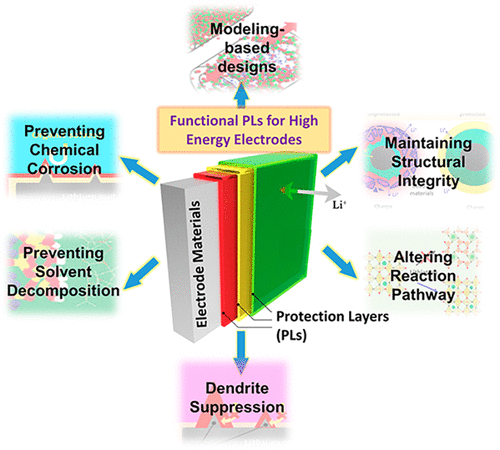当前位置:
X-MOL 学术
›
Acc. Chem. Res.
›
论文详情
Our official English website, www.x-mol.net, welcomes your feedback! (Note: you will need to create a separate account there.)
Nanoscale Protection Layers To Mitigate Degradation in High-Energy Electrochemical Energy Storage Systems
Accounts of Chemical Research ( IF 18.3 ) Pub Date : 2018-01-02 00:00:00 , DOI: 10.1021/acs.accounts.7b00524 Chuan-Fu Lin 1, 2 , Yue Qi 3 , Keith Gregorczyk 1, 2 , Sang Bok Lee 4 , Gary W. Rubloff 1, 2
Accounts of Chemical Research ( IF 18.3 ) Pub Date : 2018-01-02 00:00:00 , DOI: 10.1021/acs.accounts.7b00524 Chuan-Fu Lin 1, 2 , Yue Qi 3 , Keith Gregorczyk 1, 2 , Sang Bok Lee 4 , Gary W. Rubloff 1, 2
Affiliation

|
In the pursuit of energy storage devices with higher energy and power, new ion storage materials and high-voltage battery chemistries are of paramount importance. However, they invite—and often enhance—degradation mechanisms, which are reflected in capacity loss with charge/discharge cycling and sometimes in safety problems. Degradation mechanisms are often driven by fundamentals such as chemical and electrochemical reactions at electrode–electrolyte interfaces, volume expansion and stress associated with ion insertion and extraction, and profound inhomogeneity of electrochemical behavior. While it is important to identify and understand these mechanisms at some reasonable level, it is even more critical to design strategies to mitigate these degradation pathways and to develop means to implement and validate the strategies.
中文翻译:

纳米级保护层可缓解高能电化学储能系统中的降解
在追求具有更高能量和功率的能量存储设备时,新的离子存储材料和高压电池化学物质至关重要。但是,它们会引发(通常是增强)降解机制,这反映在充放电循环中的容量损失中,有时还反映在安全问题中。降解机理通常是由基本原理所驱动,例如电极-电解质界面的化学和电化学反应,与离子插入和提取相关的体积膨胀和应力以及电化学行为的严重不均匀性。尽管在合理的水平上识别和理解这些机制很重要,但设计缓解这些降解途径的策略并开发实施和验证策略的方法就显得尤为重要。
更新日期:2018-01-02
中文翻译:

纳米级保护层可缓解高能电化学储能系统中的降解
在追求具有更高能量和功率的能量存储设备时,新的离子存储材料和高压电池化学物质至关重要。但是,它们会引发(通常是增强)降解机制,这反映在充放电循环中的容量损失中,有时还反映在安全问题中。降解机理通常是由基本原理所驱动,例如电极-电解质界面的化学和电化学反应,与离子插入和提取相关的体积膨胀和应力以及电化学行为的严重不均匀性。尽管在合理的水平上识别和理解这些机制很重要,但设计缓解这些降解途径的策略并开发实施和验证策略的方法就显得尤为重要。



























 京公网安备 11010802027423号
京公网安备 11010802027423号